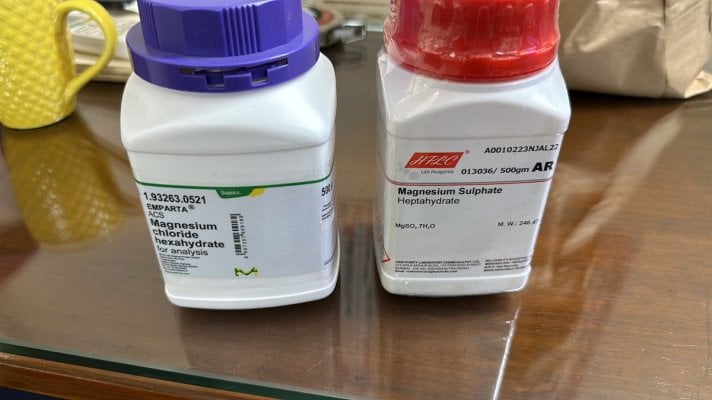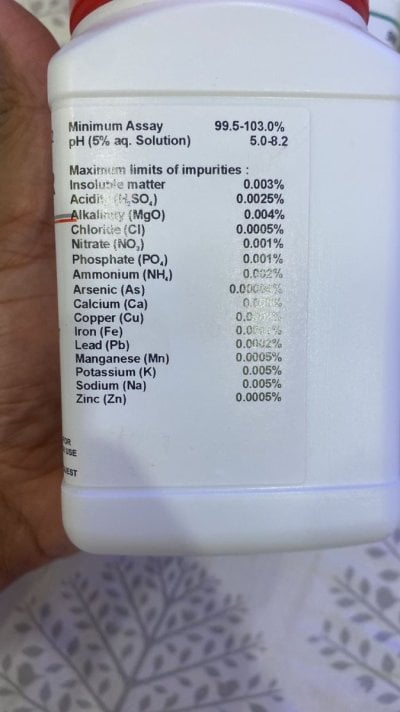I always read cup measurement whenever I read about diy additive recipes. How many grams would be equivalent to one cup? Like I wanna make magnesium solution, recipe by Randy Farley which mentions “Dissolve Epsom salts (3 cups) and magnesium chloride hexahydrate (5 cups) in enough purified freshwater to make 1 gallon total volume.” what would be the measurement in grams?
Navigation
Install the app
How to install the app on iOS
Follow along with the video below to see how to install our site as a web app on your home screen.
Note: This feature may not be available in some browsers.
More options
You are using an out of date browser. It may not display this or other websites correctly.
You should upgrade or use an alternative browser.
You should upgrade or use an alternative browser.
Cup to gram measurement
- Thread starter airvicconcre
- Start date
-
- Tags
- diy
- Tagged users None
You can't equate grams which is a unit of weight with cups which is a unit of volume. The weight will be different depending on what is in the "cup" water has one weight, table salt another, baking powder another again.
Also, the weight of the salt is going to vary based on lots of different factors. If it is salt that has been opened before, it could be absorbing moisture out of the air. That increase in moisture will increase the volume for the same weight. In other words you are now getting less salt per gram.
Also, the weight of the salt is going to vary based on lots of different factors. If it is salt that has been opened before, it could be absorbing moisture out of the air. That increase in moisture will increase the volume for the same weight. In other words you are now getting less salt per gram.
Last edited:
- Joined
- Mar 12, 2019
- Messages
- 83
- Reaction score
- 164
I’m not the mad scientist or the mathematician but….
The conversion factor between grams and cups for thin liquids is 237 grams per cup. You can convert from grams to cups or cups to grams by multiplying or dividing by 237.
In the United States, a standard 1-cup measuring cup has a defined size. It is equal to 16 tablespoons, ½ pint, ¼ quart or 8 fluid ounces. A US cup is exactly 236.588 ml, which is rounded up to 240 ml or 240 grams (if measuring liquids in weight).
The conversion factor between grams and cups for thin liquids is 237 grams per cup. You can convert from grams to cups or cups to grams by multiplying or dividing by 237.
In the United States, a standard 1-cup measuring cup has a defined size. It is equal to 16 tablespoons, ½ pint, ¼ quart or 8 fluid ounces. A US cup is exactly 236.588 ml, which is rounded up to 240 ml or 240 grams (if measuring liquids in weight).
I feel your pain, was asking myself same question.
Here in States people are not very familiar with metric system, hence those cup measures.
I would say that for Epsom Salts or Two Part Ca/Alk cup measurements are good enough.
Here in States people are not very familiar with metric system, hence those cup measures.
I would say that for Epsom Salts or Two Part Ca/Alk cup measurements are good enough.
240g
e.g. 1 US cup = 240g = 240ml. If adjusting for a metric cup (Australia, international), there will be 250 g in a cup. A UK imperial cup has the capacity for 284 g of a liquid.
You can also look at this:

 www.allrecipes.com
www.allrecipes.com
e.g. 1 US cup = 240g = 240ml. If adjusting for a metric cup (Australia, international), there will be 250 g in a cup. A UK imperial cup has the capacity for 284 g of a liquid.
You can also look at this:

Cup to Gram Conversions
Be accurate! This chart helps you convert measurements from cups to grams and ounces, depending on what your recipe calls for.
When it comes to a magnesium solution like that, you do NOT need to be that precise or exact. Just do some level scoops and call it a day. No test kit is accurate or precise enough to worry
Too TrueWhen it comes to a magnesium solution like that, you do NOT need to be that precise or exact. Just do some level scoops and call it a day. No test kit is accurate or precise enough to worry
Randy Holmes-Farley
Reef Chemist
View Badges
Staff member
Super Moderator
Excellence Award
Expert Contributor
Article Contributor
R2R Research
My Tank Thread
I give mass amounts in the original recipe article. For both of the part 3 ingredients, they were about 8 dry mass ounces per volume cup. I based the original recipe on a 64 ounce package of Epsom salt, which was 8 cups.
As folks note, there is a lot of guesswork in the mag needed per unit of alk and calcium added, so exact amounts are not critical.
As folks note, there is a lot of guesswork in the mag needed per unit of alk and calcium added, so exact amounts are not critical.
Randy Holmes-Farley
Reef Chemist
View Badges
Staff member
Super Moderator
Excellence Award
Expert Contributor
Article Contributor
R2R Research
My Tank Thread
Recipe #1, Part 3B
Dissolve a 64-ounce container of Epsom salts (about 8 cups) in enough purified freshwater to make 1 gallon total volume. This solution is added much less frequently than the other two parts. Each time you finish adding a gallon of both parts of Recipe #1, add 610 mL (2 ½ cups) of this stock solution. It can be added all at once or over time as you choose, depending on the aquarium's size and set up. Add it to a high flow area, preferably a sump. In a very small aquarium, or one without a sump, I suggest adding it slowly.
Dissolve a 64-ounce container of Epsom salts (about 8 cups) in enough purified freshwater to make 1 gallon total volume. This solution is added much less frequently than the other two parts. Each time you finish adding a gallon of both parts of Recipe #1, add 610 mL (2 ½ cups) of this stock solution. It can be added all at once or over time as you choose, depending on the aquarium's size and set up. Add it to a high flow area, preferably a sump. In a very small aquarium, or one without a sump, I suggest adding it slowly.
He
Thanking you
Zaheer


Hello Randy. Thank you for replying. It’s tough to procure brand magnesium where I am hence I have got these products which I believe should work. I’m gonna show you the chemical compound. Please if possible let me know the measurements.Recipe #1, Part 3B
Dissolve a 64-ounce container of Epsom salts (about 8 cups) in enough purified freshwater to make 1 gallon total volume. This solution is added much less frequently than the other two parts. Each time you finish adding a gallon of both parts of Recipe #1, add 610 mL (2 ½ cups) of this stock solution. It can be added all at once or over time as you choose, depending on the aquarium's size and set up. Add it to a high flow area, preferably a sump. In a very small aquarium, or one without a sump, I suggest adding it slowly.
Thanking you
Zaheer


Last edited:
This makes a lot of sense. Thanks.
You can't equate grams which is a unit of weight with cups which is a unit of volume. The weight will be different depending on what is in the "cup" water has one weight, table salt another, baking powder another again.
Also, the weight of the salt is going to vary based on lots of different factors. If it is salt that has been opened before, it could be absorbing moisture out of the air. That increase in moisture will increase the volume for the same weight. In other words you are now getting less salt per gram
Right there with yaI feel your pain, was asking myself same question.
Here in States people are not very familiar with metric system, hence those cup measures.
I would say that for Epsom Salts or Two Part Ca/Alk cup measurements are good enough.
Randy Holmes-Farley
Reef Chemist
View Badges
Staff member
Super Moderator
Excellence Award
Expert Contributor
Article Contributor
R2R Research
My Tank Thread
Yes, those are fine. Measuring by cups is going to be plenty close enough, but if you want to measure by mass/weight, then convert the recipes at 1 cup = 8 ounces = 227 g of those products (does not apply to other dry products).
Randy Holmes-Farley
Reef Chemist
View Badges
Staff member
Super Moderator
Excellence Award
Expert Contributor
Article Contributor
R2R Research
My Tank Thread
You can't equate grams which is a unit of weight with cups which is a unit of volume. The weight will be different depending on what is in the "cup" water has one weight, table salt another, baking powder another again.
Also, the weight of the salt is going to vary based on lots of different factors. If it is salt that has been opened before, it could be absorbing moisture out of the air. That increase in moisture will increase the volume for the same weight. In other words you are now getting less salt per gram.
That points out a general problem in that neither mass nor volume are perfect measures of something that may have changed by absorbing or desorbing components from or to the air.
Reminds me of a story I've told here a couple of times.
Years ago, I lived in North Carolina, which can be very humid in the summer time.
One day i noticed water droplets on the wood floor of my dining room which we had not eaten in for months.
Huh, I thought, what is that from? No pipes above the dining room, so no leaks.
What could it be from? Very perplexing.
Finally I figured out that some grains of table salt had been spilled on the floor, and in that humid environment, they absorbed moisture and became water droplets that just remained there.
Thank you.Yes, those are fine. Measuring by cups is going to be plenty close enough, but if you want to measure by mass/weight, then convert the recipes at 1 cup = 8 ounces = 227 g of those products (does not apply to other dry products).
Similar threads
- Replies
- 76
- Views
- 1,896
- Replies
- 10
- Views
- 457
- Replies
- 14
- Views
- 501
- Replies
- 13
- Views
- 724
-
- AMS: Article
- Replies
- 13
- Views
- 1,872



















